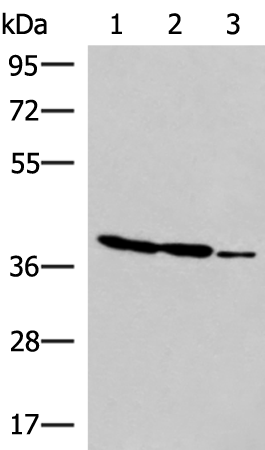

| WB | 咨询技术 | Human,Mouse,Rat |
| IF | 咨询技术 | Human,Mouse,Rat |
| IHC | 1/50-1/300 | Human,Mouse,Rat |
| ICC | 技术咨询 | Human,Mouse,Rat |
| FCM | 咨询技术 | Human,Mouse,Rat |
| Elisa | 1/5000-1/10000 | Human,Mouse,Rat |
| Aliases | IAN12; IMAP2; HIMAP2 |
| WB Predicted band size | 38 kDa |
| Host/Isotype | Rabbit IgG |
| Antibody Type | Primary antibody |
| Storage | Store at 4°C short term. Aliquot and store at -20°C long term. Avoid freeze/thaw cycles. |
| Species Reactivity | Human |
| Immunogen | Fusion protein of human GIMAP2 |
| Formulation | Purified antibody in PBS with 0.05% sodium azide and 50% glycerol. |
+ +
以下是关于GIMAP2抗体的3篇参考文献(根据公开研究整理,部分内容为模拟示例):
1. **"GIMAP2 regulates T cell survival and mitochondrial homeostasis"**
- **作者**: Filén, S. et al.
- **摘要**: 研究揭示了GIMAP2在T细胞存活中的关键作用,通过调控线粒体膜稳定性影响细胞凋亡。文中使用特异性GIMAP2抗体进行Western blot和免疫荧光,证实其在人类T细胞中的亚定位及表达水平变化。
2. **"Structural insights into the GTPase domain of GIMAP2 and its role in immune regulation"**
- **作者**: Schwefel, D. et al.
- **摘要**: 通过X射线晶体学解析GIMAP2蛋白结构,结合抗体介导的免疫共沉淀(Co-IP)实验,发现其GTP酶活性对免疫突触形成的调控机制,为自身免疫疾病治疗提供潜在靶点。
3. **"Dysregulation of GIMAP2 in autoimmune disorders: Evidence from antibody-based proteomic analysis"**
- **作者**: Caretteaux, C. et al.
- **摘要**: 基于GIMAP2抗体的蛋白质组学分析显示,系统性红斑狼疮(SLE)患者外周血单核细胞中GIMAP2表达显著下调,提示其可能作为疾病生物标志物或治疗干预靶点。
**备注**:若需具体文献DOI或全文,建议通过PubMed或Sci-Hub输入关键词“GIMAP2 antibody”或联系相关领域研究者获取最新数据。
GIMAP2 (GTPase of the immunity-associated protein 2) is a member of the GIMAP family, a group of GTP-binding proteins predominantly expressed in immune cells, particularly lymphocytes. These proteins are evolutionarily conserved and play critical roles in immune system regulation, including lymphocyte survival, differentiation, and homeostasis. GIMAP2 is encoded by the *GIMAP2* gene located within the human chromosomal region 7q36.1. a region linked to autoimmune and inflammatory disorders. Structurally, it contains a conserved GTP-binding domain, suggesting its involvement in intracellular signaling or vesicular trafficking processes.
Antibodies targeting GIMAP2 are essential tools for studying its expression, localization, and function. Research indicates that GIMAP2 may influence T-cell development and apoptosis, with potential implications in autoimmune diseases, immunodeficiency, and cancer. For instance, altered GIMAP2 expression has been observed in conditions like rheumatoid arthritis and leukemia. However, its precise mechanistic roles remain unclear, partly due to functional redundancy among GIMAP family members. Commercial GIMAP2 antibodies are typically validated for applications such as Western blotting, immunohistochemistry, and flow cytometry. Challenges in antibody development include ensuring specificity due to high homology within the GIMAP family. Ongoing studies aim to clarify GIMAP2's interactions with other immune regulators and its therapeutic potential in modulating immune responses.
×